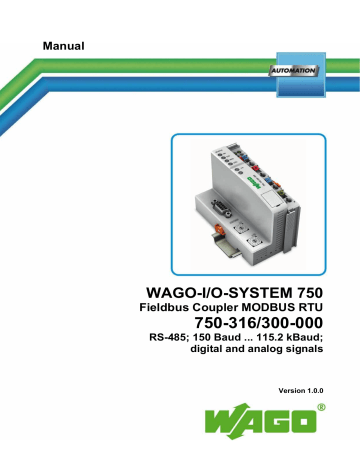advertisement

WAGO-I/O-SYSTEM 750
750-316/300-000 Fieldbus Coupler MODBUS RTU
Mounting 59
5.3 Mounting onto Carrier Rail
5.3.1 Carrier Rail Properties
All system components can be snapped directly onto a carrier rail in accordance with the European standard EN 50022 (DIN 35).
Do not use any third-party carrier rails without approval by WAGO!
WAGO Kontakttechnik GmbH & Co. KG supplies standardized carrier rails that are optimal for use with the I/O system. If other carrier rails are used, then a technical inspection and approval of the rail by WAGO Kontakttechnik GmbH &
Co. KG should take place.
Carrier rails have different mechanical and electrical properties. For the optimal system setup on a carrier rail, certain guidelines must be observed:
• The material must be non-corrosive.
• Most components have a contact to the carrier rail to ground electromagnetic disturbances. In order to avoid corrosion, this tin-plated carrier rail contact must not form a galvanic cell with the material of the carrier rail which generates a differential voltage above 0.5 V (saline solution of 0.3 % at 20°C).
• The carrier rail must optimally support the EMC measures integrated into the system and the shielding of the I/O module connections.
• A sufficiently stable carrier rail should be selected and, if necessary, several mounting points (every 20 cm) should be used in order to prevent bending and twisting (torsion).
• The geometry of the carrier rail must not be altered in order to secure the safe hold of the components. In particular, when shortening or mounting the carrier rail, it must not be crushed or bent.
• The base of the I/O components extends into the profile of the carrier rail.
For carrier rails with a height of 7.5 mm, mounting points are to be riveted under the node in the carrier rail (slotted head captive screws or blind rivets).
• The medal springs on the bottom of the housing must have low-impedance contact with the DIN rail (wide contact surface is possible).
Manual
Version 1.0.0
advertisement
Related manuals
advertisement
Table of contents
- 6 Notes about this Documentation
- 6 Validity of this Documentation
- 6 Copyright
- 7 Symbols
- 9 Number Notation
- 9 Font Conventions
- 10 Important Notes
- 10 Legal Bases
- 10 Subject to Changes
- 10 Personnel Qualifications
- 10 Provisions
- 11 Technical Condition of Specified Devices
- 12 Safety Advice (Precautions)
- 14 System Description
- 15 Manufacturing Number
- 16 Component Update
- 16 Storage, Assembly and Transport
- 17 Assembly Guidelines/Standards
- 18 Power Supply
- 18 Isolation
- 19 System Supply
- 19 Connection
- 20 Dimensioning
- 23 Field Supply
- 23 Connection
- 25 Fusing
- 28 Supplementary Power Supply Regulations
- 29 Supply Example
- 31 Power Supply Unit
- 32 Grounding
- 32 Grounding the DIN Rail
- 32 Framework Assembly
- 32 Insulated Assembly
- 33 Grounding Function
- 34 Shielding
- 34 General
- 34 Bus Cables
- 35 Signal Lines
- 35 WAGO Shield Connecting System
- 36 Device Description
- 39 Connectors
- 39 Device Supply
- 40 Fieldbus Connection
- 41 Display Elements
- 42 Operating Elements
- 42 Service Interface
- 43 Mode Selector Switch
- 49 Manual Configuration
- 52 Technical Data
- 52 Device Data
- 52 System Data
- 52 Connection Type
- 53 Climatic Environmental Conditions
- 53 Mechanical Strength acc. to IEC
- 54 Approvals
- 56 Standards and Guidelines
- 57 Mounting
- 57 Installation Position
- 57 Overall Configuration
- 59 Mounting onto Carrier Rail
- 59 Carrier Rail Properties
- 60 WAGO DIN Rail
- 60 Spacing
- 61 Mounting Sequence
- 62 Inserting and Removing Devices
- 63 Inserting the Fieldbus Coupler/Controller
- 63 Removing the Fieldbus Coupler/Controller
- 64 Inserting the I/O Module
- 65 Removing the I/O Module
- 66 Connect Devices
- 66 Data Contacts/Internal Bus
- 67 Power Contacts/Field Supply
- 69 Function Description
- 69 Startup of the Fieldbus Coupler
- 71 Process Data Architecture
- 71 Basic Setup
- 72 Example of an Input Process Image
- 73 Example of an Output Process Image
- 74 Process Data MODBUS RTU
- 75 Data Exchange
- 75 Memory Space
- 76 Addressing
- 76 Adressing the I/O Modules
- 79 Commissioning
- 80 Diagnostics
- 80 LED Signaling
- 81 Evaluating Fieldbus Status
- 82 Evaluating Node Status – I/O LED (Blink Code Table)
- 163 Figure 1: Fieldbus Node (Example)
- 164 Figure 2: Labeling on the Side of a Component (Example)
- 164 Figure 3: Example of a Manufacturing Number
- 167 Figure 4: Isolation for Fieldbus Couplers/Controllers (Example)
- 168 System Supply Module (right)
- 169 Couplers
- 174 Figure 8: Supply Module with Fuse Carrier (Example 750-610)